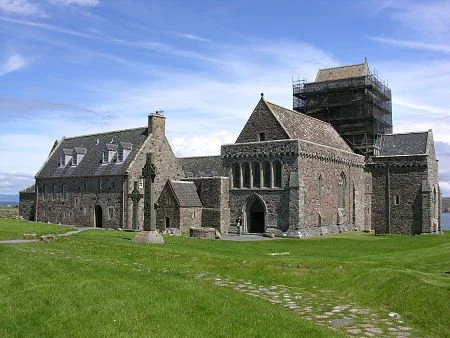In the fall of 2022, my husband and I took a trip that included thirteen countries; the leading of two conferences; staying with new artist staff; riding trains throughout Europe; and so much more. It was truly a “trip of a lifetime” that will probably not be attempted again by us.
One of the unique aspects of this extended trip was the planning of three “spiritual renewal” places and times just for us to meet with God. We chose three very different places, but all had a history of being “thin places” where heaven and earth seem to meet and pilgrims have experienced special times with God throughout centuries. The first place was an island off the Scottish coast called Iona. This remote destination was first established by the Celtic monk, Columba, and twelve fellow monks as a monastery, abbey and nunnery in 563 A.D. It is known as the birthplace of Christianity in Scotland. From this place, monasteries were established through Europe. We were enthralled with the testimonies of people throughout the ages who spent time in prayer and meditation there and had life-changing experiences with God. Unfortunately, for us, we were there much too short of a stay to spend the time we wanted in reflection and meditation. We felt more like tourists than people on a pilgrimage.
Halfway through our twelve week journey, we had planned a weekend in Chartres, France. The magnificent cathedral dominated the town, as we disembarked from the train. It was as if the streets were designed much like the famous labyrinth, surrounding the Cathedral Square. I was eager to enter the sanctuary and engage in personal meditation and prayer as I walked the 13th Century labyrinth, the largest built in the Middle Ages. I was stunned to see it completely covered with chairs, having only the center of the labyrinth visible in an aisle! Upon questioning one of the workers in the gift shop, I learned the the labyrinth was covered the night before and would not be uncovered until the Lenten season—seven months later. I was so disappointed. Again, my expectation of meeting with God in a special place were dashed.
Florence, Italy was the final place I had anticipated as a spiritual retreat. Specifically, I desired to spend time in the cells of the monks St. Marco’s Monastery-where, in the 15th Century a humble monk known as Fra Angelico painted beautiful paintings in these small rooms where the monks slept. This artwork was done solely for devotional purposes—not to be seen by the public. It was clearly an example of Visio Divina being done each morning by these men and women dedicated to God. For several years I have dreamed of spending time in these small cells, seeking God, and exercising my own Vision Divina. To my dismay, when I arrived in the monastery, each room was roped off at the door and all that I could do was lean into the room to see the art on the wall. I learned that some “tourist” had tried to deface some of the paintings, so the cells were not accessible any more. I was so disappointed. I begged the docent to allow me some time in at least one of the cells, but the rules would not allow it. Again, my seeking a special place to meet God was thwarted.
So—what did I learn from these experiences of frustration? After much prayer and contemplation, I realized God was teaching me that it is not necessary to have a special place to meet with Him because He was available to me anywhere and everywhere. While these “thin places” have had a significance to many pilgrims in the past, they were not the special key to experiencing a deepening relationship with God. I do believe that such places exist—they just are not required. I love beauty and I feel close to God whenever I’m in the presence of beauty—whether in nature or manmade. Wherever. . . whenever I engage with God becomes a “thin place” for me.
But from there, you will seek the LORD your God, and you will find Him if you search for Him with all your heart and all your soul. Deuteronomy 4:29
